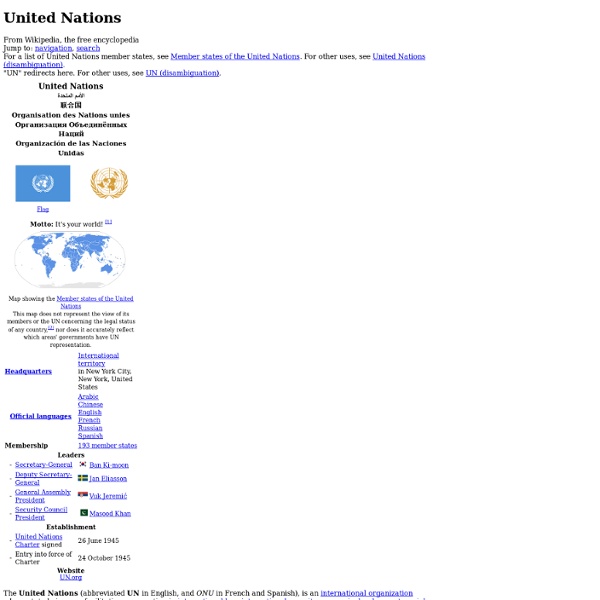World Bank
The World Bank is a United Nations international financial institution that provides loans[3] to developing countries for capital programs. The World Bank is a component of the World Bank Group, and a member of the United Nations Development Group. Composition[edit] World Bank[edit] The World Bank is composed of two institutions: World Bank Group[edit] The World Bank should not be confused with the United Nations World Bank Group, a member of the United Nations Economic and Social Council, and a family of five international organizations that make leveraged loans to poor countries which is comprised of the:[6] History[edit] The World Bank was created at the 1944 Bretton Woods Conference, along with three other institutions, including the International Monetary Fund (IMF). Although many countries were represented at the Bretton Woods Conference, the United States and United Kingdom were the most powerful in attendance and dominated the negotiations.[8]:52–54 1944–1968[edit] 1968–1980[edit]
UN - United Nations
Food and Agriculture Organization
The Food and Agriculture Organization of the United Nations (FAO; French: Organisation des Nations unies pour l'alimentation et l'agriculture, Italian: Organizzazione delle Nazioni Unite per l'Alimentazione e l'Agricoltura) is an agency of the United Nations that leads international efforts to defeat hunger. Serving both developed and developing countries, FAO acts as a neutral forum where all nations meet as equals to negotiate agreements and debate policy. FAO is also a source of knowledge and information, and helps developing countries and countries in transition modernize and improve agriculture, forestry and fisheries practices, ensuring good nutrition and food security for all. Its Latin motto, fiat panis, translates as "let there be bread". As of 8 August 2013[update], FAO has 194 member states, along with the European Union (a "member organization"), and the Faroe Islands and Tokelau, which are associate members.[1] History[edit] Structure and finance[edit] Budget[edit] Food[edit]
FAO
International Monetary Fund Home Page
International Monetary Fund
The International Monetary Fund (IMF) is an international organization headquartered in Washington, D.C., of "188 countries working to foster global monetary cooperation, secure financial stability, facilitate international trade, promote high employment and sustainable economic growth, and reduce poverty around the world."[1] Formed in 1944 at the Bretton Woods Conference, it came into formal existence in 1945 with 29 member countries and the goal of reconstructing the international payment system. Countries contribute funds to a pool through a quota system from which countries experiencing balance of payments difficulties can borrow money. Functions[edit] The IMF's role was fundamentally altered by the floating exchange rates post-1971. Surveillance of the global economy[edit] IMF Data Dissemination Systems participants: IMF member using SDDS IMF member using GDDS IMF member, not using any of the DDSystems non-IMF entity using SDDS non-IMF entity using GDDS no interaction with the IMF Notes
Intergovernmental organization
An intergovernmental organization (or international governmental organization; IGO) is an organization composed primarily of sovereign states (referred to as member states), or of other intergovernmental organizations. Intergovernmental organizations are often called international organizations, although that term may also include international nongovernmental organization such as international nonprofit organizations or multinational corporations. Intergovernmental organizations are an important aspect of public international law. IGOs are established by treaty that acts as a charter creating the group. Intergovernmental organizations in a legal sense should be distinguished from simple groupings or coalitions of states, such as the G8 or the Quartet. Intergovernmental organizations must also be distinguished from treaties. Types and purposes[edit] Intergovernmental organizations differ in function, membership and membership criteria. Examples[edit] United Nations[edit] Mission Membership
Human Development Reports (HDR) – United Nations Development Programme (UNDP)
The Centre for Independent Studies
Millennium Development Goals
The Millennium Development Goals are a UN initiative. The Millennium Development Goals (MDGs) are eight international development goals that were established following the Millennium Summit of the United Nations in 2000, following the adoption of the United Nations Millennium Declaration. All 189 United Nations member states at the time (there are 193 currently) and at least 23 international organizations committed to help achieve the Millennium Development Goals by 2015, the goals follow: Each goal has specific targets and dates for achieving those targets. Criticisms accompanied the MDGs, focusing on lack of analysis and justification behind the chosen objectives, the difficulty or lack of measurements for some goals and uneven progress, among others. As of 2013 progress towards the goals was uneven. Background[edit] Millennium Summit[edit] MDGs derive from earlier development targets, where world leaders adopted the United Nations Millennium Declaration. Precursors[edit] Goals[edit]



